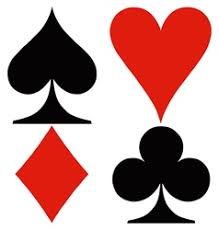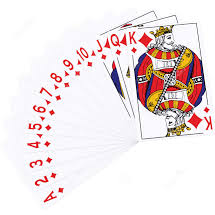Science > Mathematics > Statistics and Probability > Probability > Problems Based on Drawing 3 Playing Cards
In the last few articles, we have seen to solve problems based on tossing of coins, throwing dice, and selecting numbered cards. In this article, we shall study the problems to find the probability involving the draw of three playing cards. For e.g. three cards are drawn from a well-shuffled pack of 52 playing cards. Find the probability of getting all red cards

Problems based on the Draw of 3 Playing Cards:
Example – 01:
Three cards are drawn from a well-shuffled pack of 52 playing cards. Find the probability of getting
Solution:
There are 52 cards in a pack.
Three cards out of 52 can be drawn by 52C3 ways
Hence n(S) = 52C3 = 26 x 17 x 50
a) all face cards
Let A be the event of getting all face cards
There are 12 face cards in a pack
three face cards out of 12 can be drawn by 12C3 ways
∴ n(A) = 12C3 = 4 x 11 x 5
By the definition P(A) = n(A)/n(S) = (4 x 11 x 5)/( 26 x 17 x 50) = 11/1105
Therefore the probability of getting all face cards is 11/1105
b) no face card
Let B be the event of getting no face card
There are 12 face cards in a pack
Thus there are 40 non-face cards in a pack
three non-face cards out of 40 can be drawn by 40C3 ways
∴ n(B) = 40C3 = 20 x 13 x 38
By the definition P(B) = n(B)/n(S) = (20 x 13 x 38)/( 26 x 17 x 50) = 38/85
Therefore the probability of getting no face card is 38/85.
c) atleast one face card
Let C be the event of getting at least one face card
Thus C is an event of getting no face card
There are 12 face cards in a pack
Thus there are 40 non-face cards in a pack
three non-face cards out of 40 can be drawn by 40C3 ways
∴ n(C) = 40C3 = 20 x 13 x 38
By the definition P(C) = n(C)/n(S) = (20 x 13 x 38)/( 26 x 17 x 50) = 38/85
Now P(C) = 1 – P(C) = 1 – 38/85 = 47/85
Therefore the probability of getting at least one face card is 47/85.
d) at least two face cards
Let D be the event of getting at least two face cards
There are two possibilities
Case – 1: Getting two face cards and 1 non-face card
Case – 2: All three face cards
There are 12 face cards in a pack
Thus there are 40 non-face cards in a pack
∴ n(D) = 12C2 x 40C1 + 12C3 = 6 x 11 x 40 + 4 x 11 x 5 = 2860
By the definition P(D) = n(D)/n(S) = 3794/( 26 x 17 x 50) = 11/85
Therefore the probability of getting at least two face cards is 11/85.
e) at most two face cards
Let E be the event of getting at most two face cards
There are three possibilities
Case – 1: Getting no face card
Case – 2: Getting one face card and 2 non-face cards
Case – 3: Getting two face cards and 1 non-face card
There are 12 face cards in a pack
Thus there are 40 non-face cards in a pack
∴ n(E) = 40C3 +12C1 x 40C2 + 12C2 x 40C1 = 20 x 13 x 38 + 12 x 20 x 39 + 6 x 11 x 40 = 21880
By the definition P(E) = n(E)/n(S) = 21880/( 26 x 17 x 50) = 1094/1105
Therefore the probability of getting at most two face cards is 1094/1105
f) all red cards
Let F be the event of getting all red cards
There are 26 red cards in a pack
three red cards out of 26 red cards can be drawn by 26C3 ways
∴ n(E) = 26C3 = 4 x 11 x 5 = 13 x 25 x 8
By the definition P(E) = n(E)/n(S) = (13 x 25 x 8)/( 26 x 17 x 50) = 2/17
Therefore the probability of getting all red cards is 2/17
f) all are not heart
Let F be the event of getting draw such that all are not heart
Thus F is the event that the draw consists of atmost two heart
There are three possibilities
Case – 1: Getting no heart
Case – 2: Getting one heart and 2 non hearts
Case – 3: Getting two hearts and 1 non heart
There are 13 heart cards in a pack
Thus there are 39 non-heart cards in a pack
∴ n(F) = 39C3 +13C1 x 39C2 + 13C2 x 39C1 = 13 x 19 x 37 + 13 x 39 x 19 + 13 x 6 x 39 = 21814
By the definition P(F) = n(F)/n(S) = 21814/( 26 x 17 x 50) = 839/850
Therefore the probability of getting all not heart is 839/850
g) atleast one heart
Let G be the event of getting at least one heart
Thus G’ is an event of getting no heart
There are 13 heart cards in a pack
Thus there are 39 non-heart cards in a pack
three non-heart cards out of 39 non-heart cards can be drawn by 39C3 ways
∴ n(G’) = 39C3 = 13 x 19 x 37
By the definition P(G’) = n(G’)/n(S) = (13 x 19 x 37)/( 26 x 17 x 50) = 703/1700
Now P(G) = 1 – P(G’) = 1 – 703/1700 = 997/1700
Therefore the probability of getting at least one heart is 997/1700
h) a king, a queen, and a jack
Let H be the event of getting a king, a queen, and a jack
There are 4 kings, 4 queens and 4 jacks in a pack
Each specific selection can be done by 4C1 ways
∴ n(H) = 4C1 x 4C1 x 4C1 = 4 x 4 x 4 = 64
By the definition P(H) = n(H)/n(S) =64/( 26 x 17 x 50) = 16/5525
Therefore the probability of getting a king, a queen and a jack is 16/5525
i) 2 aces and 1 king
Let J be the event of getting two aces and 1 king
There are 4 aces and 4 kings
∴ n(J) = 4C2 x 4C1 = 6 x 4 = 24
By the definition P(J) = n(J)/n(S) =24/( 26 x 17 x 50) = 6/5525
Therefore the probability of getting two aces and one king is 6/5525
In the next article, we shall study some basic problems of probability based on the drawing of four or more cards from a pack of playing cards.
